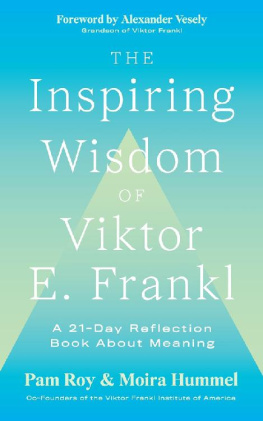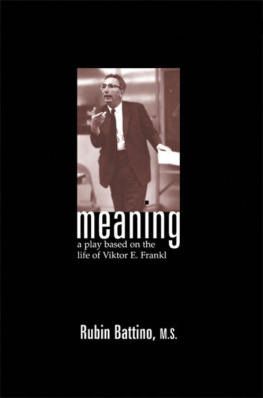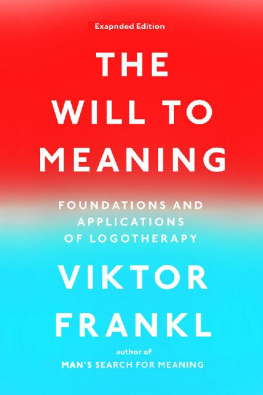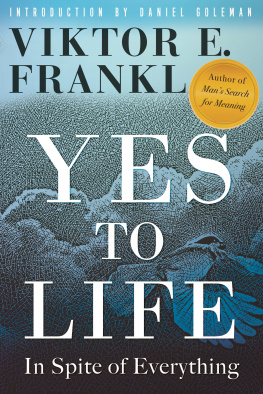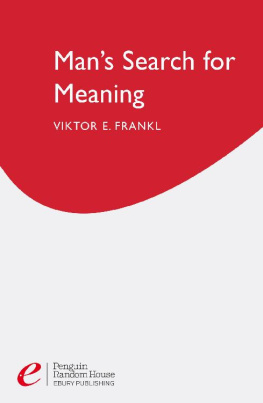Context
During World War II (19391945), millions of people suffered the physical and existential terror of the Nazi concentration camps. The names now are famous: Dachau, Buchenwald, Auschwitz-Birkenau (the largestand, unlike the others, a combined death camp and labor camp). At the time war was declared, Viktor E. Frankl was a respected psychiatrist at the Rothschild Hospital in Vienna, Austria. His work had already made a great impact in his field. He had begun several highly successful programs to treat suicidal patients, and his opinions on psychological matters were highly sought-after across Europe, even by well-respected psychoanalysts such as Wilhelm Reich and Sigmund Freud. After the Nazi Anschluss the German occupation of Austriain 1938, Frankl was legally disallowed from treating Aryans, or non-Jews. Along with millions of other Jews, he and his family were persecuted and eventually detained in Theresienstadt and Auschwitz. A successful psychiatrist with a probing mind, Frankl used much of what hed learned about human psychology to surviveand help others survivethe camps. After a long and brutal imprisonment, during which almost all of his family perished, he was one of the few to walk out of Auschwitz at the end of the war.
Frankl wrote a book about his experiences, describing in detail the lessons in human psychology he had gleaned from the extreme conditions of the camps. Nevertheless, Say Yes to Life , written in German and distributed under many other titles, was published anonymously in 1946, since Frankl didnt believe it would have much public impact. But demand for the book soon grew. When the English translation, titled Mans Search for Meaning , was finally published in 1959, it sold millions of copies. To this day, it is reprinted regularly.
The central idea of Frankls work was the practice of logotherapy, a Greek-based term that more or less translates to meaning therapy. Never as broadly popularized as Freuds psychotherapy or Rogerian group therapy, logotherapy is nonetheless spectacularly effective in treating patients with suicidal thoughts, midlife crises, depression, and various other conditions. The process of logotherapy involves seeking out, discovering, and naming what can be said to be the true meaning of your individual life, whether that meaning centers on love, family, work, or something else.
Since his death in 1997, Frankls work has been carried forward in numerous logotherapy institutes across the world. His most popular book, Mans Search for Meaning , remains a classic that continues to be read by new generations each decade.
Overview
Viktor Frankls classic Mans Search for Meaning can be seen as both a memoir of his years in Nazi concentration camps and a founding document for the field of logotherapy. The first and largest section of the book covers Frankls own experiences in both large and small camps across Nazi-occupied territory, going into vivid detail about the conditions, agonies, and day-to-day grind of being a prisoner under a criminal regime in Europe. He makes the point, though, that the story he tells is not about the heroes and martyrs fighting tyranny in extremis , but rather the common experiences of regular prisonersaverage family people and workersmany of whom he watched die in the camps.
The experience of a Nazi concentration camp is one of unimaginable suffering. The all-powerful institution of violence and coercion effectively controlled every aspect of daily life for Frankl and the other prisoners, leaving little room for the ordinary. The camps were a reality unto themselvesallowing no communication with the outside worldand the daily experience of violence, murder, starvation, and deprivation kept the surviving inmates disempowered and docile. Still, Frankl discovered some surprising things about human resilience and psychology, ideas that challenged the eras preconceptions about physical and mental well-being. How was it that people could survive such an ordeal? What kinds of reactions did different people have, and could those reactions be examined and categorized?
Frankl was already a well-known doctor at the Rothschild Hospital in Vienna, and inmates and Nazi officials alike sought after his expertise during his time in the camps. His background and profession proved useful. He was stationed in the typhus block, where he aided the sickthough it wasnt much of a recovery clinicand occasionally one of the guards took a liking to him for his willingness to listen to personal stories and offer advice. Because of this, Frankl had more consistent and regular interaction with the variety of personalities there, and he was able to see things both from the perspective of the officials and from the viewpoint of enslaved laborersthe thriving and the dying.
In secret, he took shorthand notes on scraps of paper, remarking on the notable or widespread responses of moral apathy, depersonalization, extinguished sex drive, gallows humor, suicidal tendencies, and the physical and emotional responses of people when subjected to long-term starvation and sleep deprivation. Frankl noted that suffering, whether a small or large amount of it, completely fills the human soul and conscious mind, making ordinary existence impossible and stoking a range of reactions that would be impossible to imagine in any other circumstances.
Still, the book offers insights on and a direct challenge to the idea of surviving that is still the accepted notion today, providing a reasoned contradiction of the idea that only the strong make it through while the weak perish. In many ways, Frankl found the opposite to be true. He describes young, healthy, physically exemplary prisoners who were some of the first to perish, noting to himself, with some surprise, that someone who was physically weaker often had a better chance of surviving if he had a rich inner life. This was where Frankl began to take note of the power of meaningfulness in a persons life. Intellectual life in the camp was totally absent, and those prisoners who turned to their own memories of great literature and ideasFrankl quotes Dostoevsky, Tolstoy, the Bible, Thomas Mann, and otherstended to have the moral stamina not only to survive, but also to act selflessly for others in the face of great personal risk. This idea became the basis for logotherapy.









